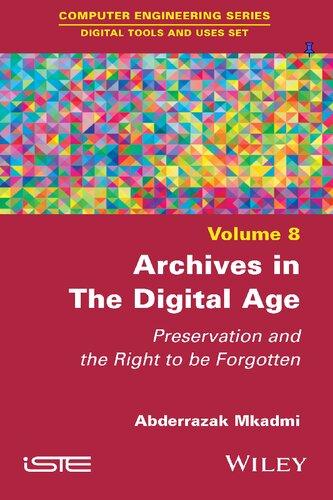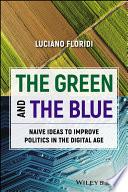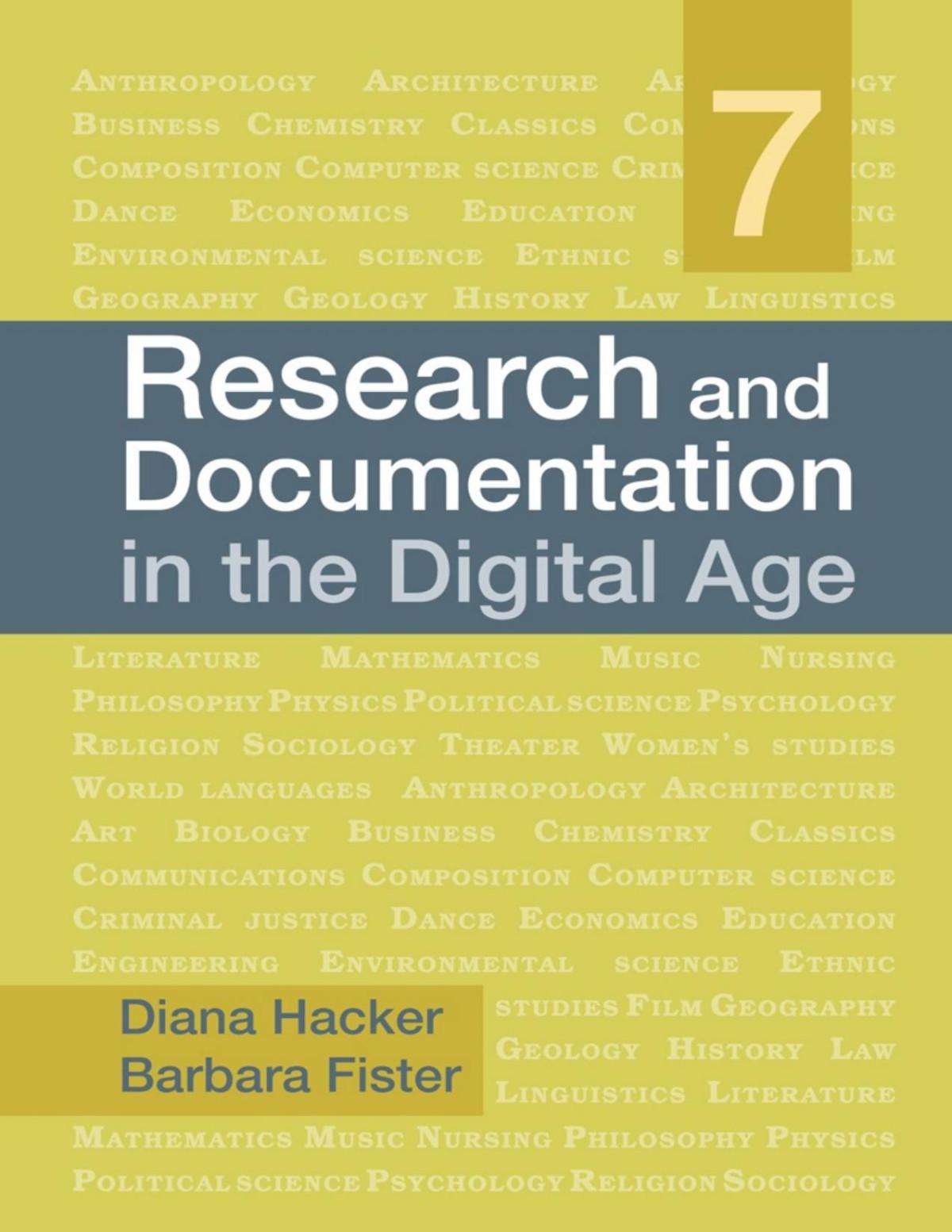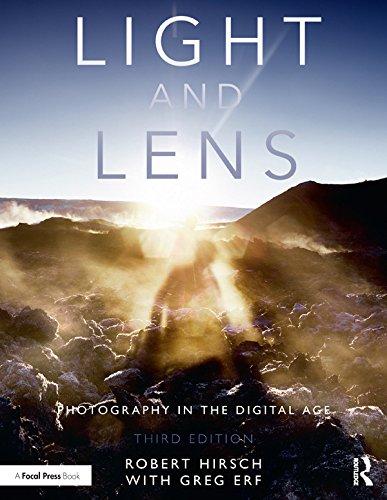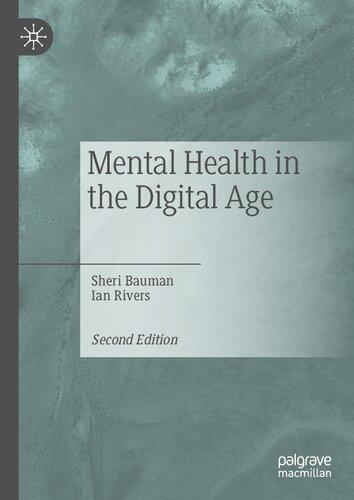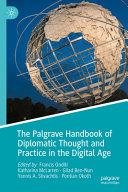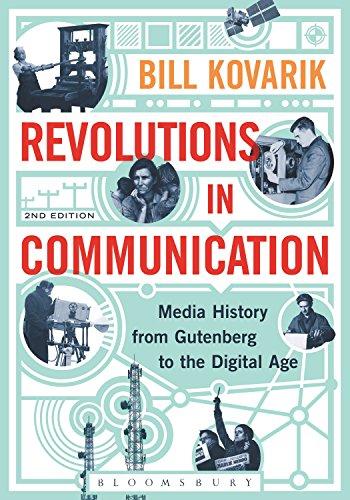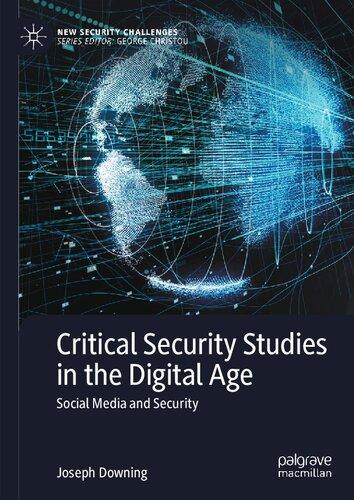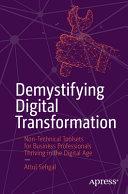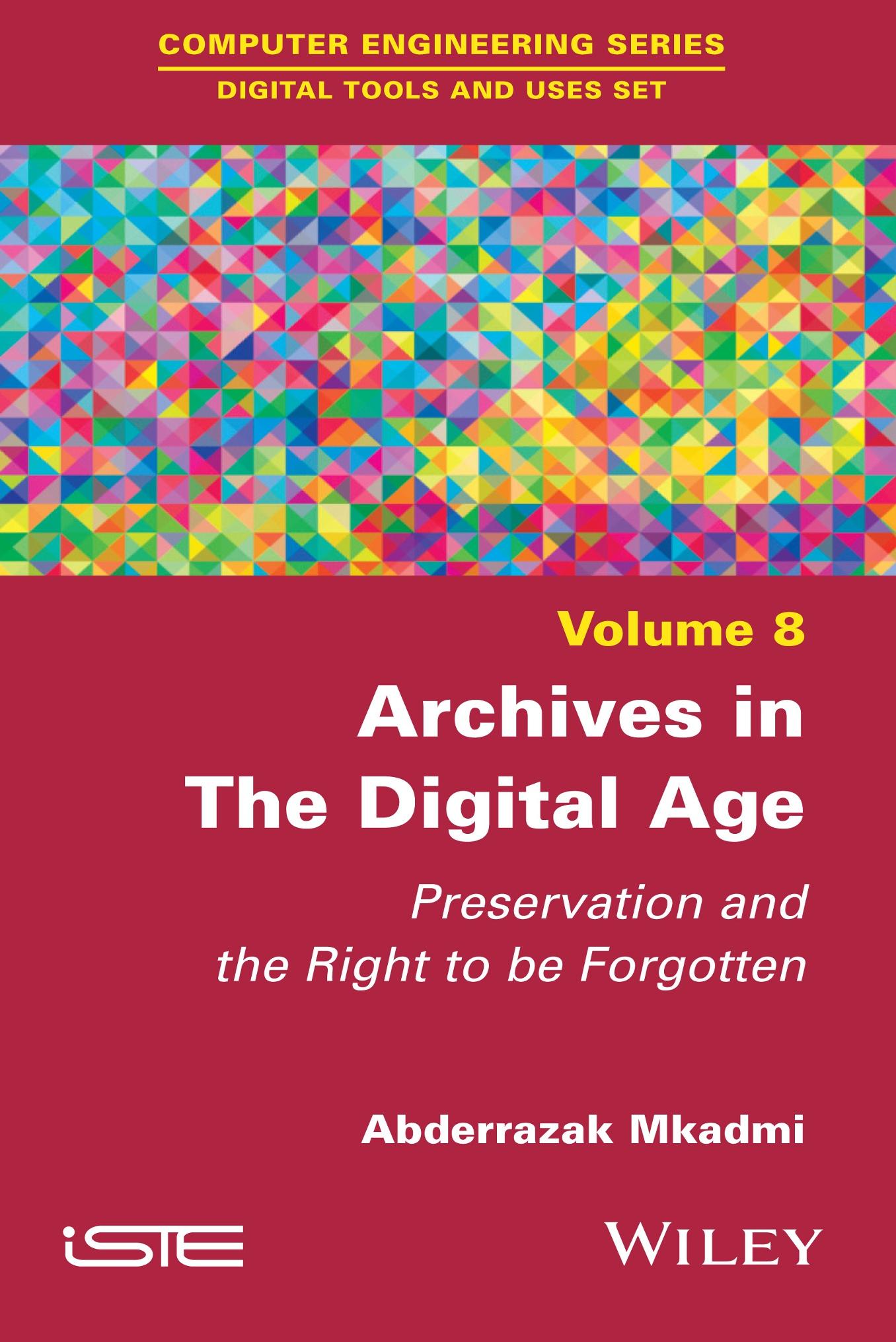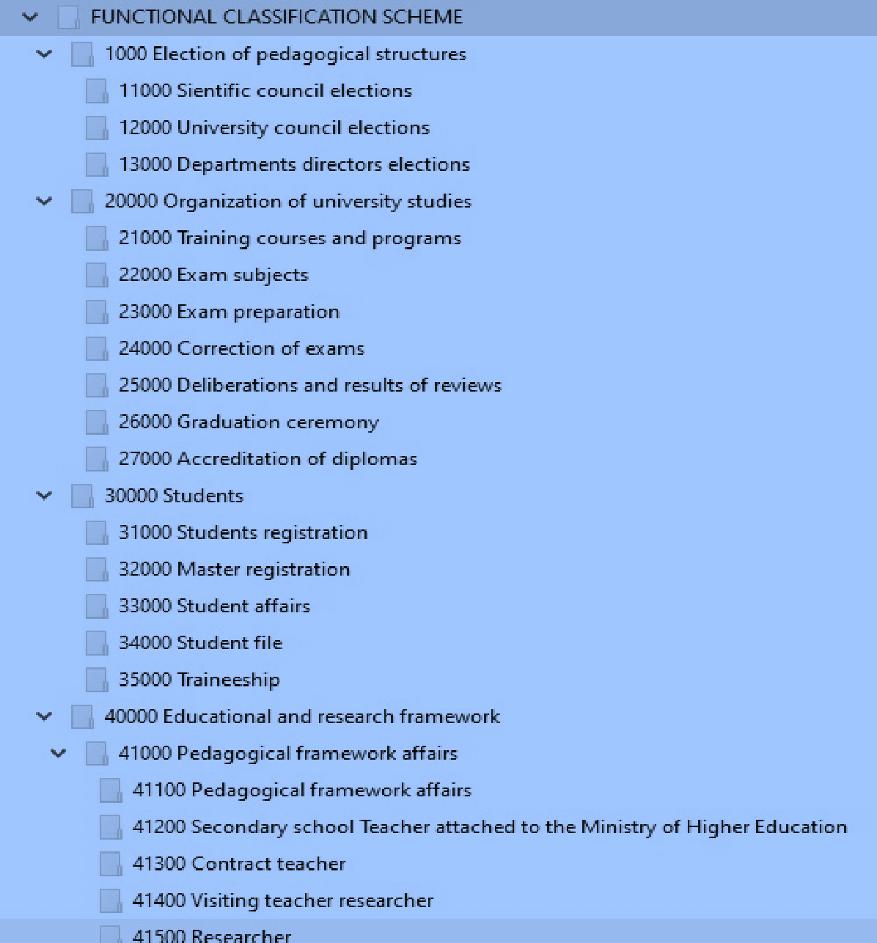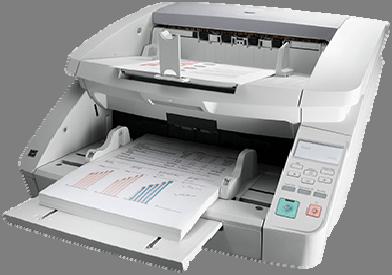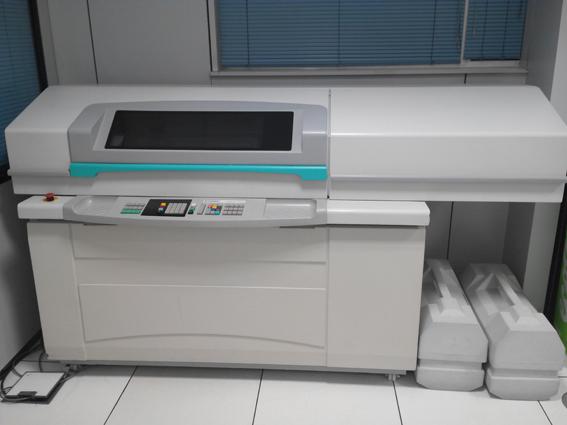Visit to download the full and correct content document: https://ebookmass.com/product/archives-in-the-digital-age-preservation-and-the-rightto-be-forgotten-abderrazak-mkadmi/
More products digital (pdf, epub, mobi) instant download maybe you interests ...
The Green and The Blue: Naive Ideas to Improve Politics in the Digital Age Luciano Floridi
https://ebookmass.com/product/the-green-and-the-blue-naive-ideasto-improve-politics-in-the-digital-age-luciano-floridi/
Research and Documentation in the Digital Age Diana Hacker & Barbara Fisher
https://ebookmass.com/product/research-and-documentation-in-thedigital-age-diana-hacker-barbara-fisher/
Light and Lens: Photography in the Digital Age 3rd Edition, (Ebook PDF)
https://ebookmass.com/product/light-and-lens-photography-in-thedigital-age-3rd-edition-ebook-pdf/
Mental Health in the Digital Age 2nd Edition Sheri
Bauman
https://ebookmass.com/product/mental-health-in-the-digitalage-2nd-edition-sheri-bauman/
The Palgrave Handbook of Diplomatic Thought and Practice in the Digital Age Francis Onditi
https://ebookmass.com/product/the-palgrave-handbook-ofdiplomatic-thought-and-practice-in-the-digital-age-francisonditi/
Revolutions in Communication: Media History from Gutenberg to the Digital Age 2nd Edition, (Ebook PDF)
https://ebookmass.com/product/revolutions-in-communication-mediahistory-from-gutenberg-to-the-digital-age-2nd-edition-ebook-pdf/
Critical Security Studies in the Digital Age: Social Media and Security Joseph Downing
https://ebookmass.com/product/critical-security-studies-in-thedigital-age-social-media-and-security-joseph-downing/
Demystifying Digital Transformation: Non-Technical Toolsets for Business Professionals Thriving in the Digital Age Attul Sehgal
https://ebookmass.com/product/demystifying-digitaltransformation-non-technical-toolsets-for-business-professionalsthriving-in-the-digital-age-attul-sehgal/
Repression in the Digital Age: Surveillance, Censorship, and the Dynamics of State Violence Anita R. Gohdes
https://ebookmass.com/product/repression-in-the-digital-agesurveillance-censorship-and-the-dynamics-of-state-violence-anitar-gohdes/
Archives in The Digital Age
Imad Saleh
First published 2021 in Great Britain and the United States by ISTE Ltd and John Wiley & Sons, Inc.
Apart from any fair dealing for the purposes of research or private study, or criticism or review, as permitted under the Copyright, Designs and Patents Act 1988, this publication may only be reproduced, stored or transmitted, in any form or by any means, with the prior permission in writing of the publishers, or in the case of reprographic reproduction in accordance with the terms and licenses issued by the CLA. Enquiries concerning reproduction outside these terms should be sent to the publishers at the undermentioned address:
ISTE Ltd
John Wiley & Sons, Inc.
27-37 St George’s Road 111 River Street London SW19 4EU Hoboken, NJ 07030
UK USA
www.iste.co.uk
www.wiley.com
© ISTE Ltd 2021
The rights of Abderrazak Mkadmi to be identified as the author of this work have been asserted by him in accordance with the Copyright, Designs and Patents Act 1988.
Library of Congress Control Number: 2021930486
British Library Cataloguing-in-Publication Data
A CIP record for this book is available from the British Library
ISBN 978-1-78630-676-0
2.1.
2.2. Digital archiving: elements of
2.3. Digital archiving: the essential standards
2.3.1. NF Z 42-013/ISO 14641
2.3.2. NF 461: electronic archiving system
2.3.3. OAIS (ISO 14721): Open Archival Information System
2.3.4. ISO 19905 (PDF/A)
2.3.5. ISO 30300, ISO 30301 and ISO 30302
2.3.6.
2.4. Methodology for setting up a digital archiving process
2.4.1. Qualifying and
2.4.2.
2.4.3.
2.4.4.
2.4.5.
2.5.
2.5.3.
2.6.2.
3.2.
3.2.1. “Literary and Linguistic Computing”: 1940–1980
3.2.2. “Humanities computing”: 1980–1994
3.2.3. “Digital humanities”: since
3.3.
3.4. Archives in the age of the digital
3.4.1.
3.4.2.
3.4.3.
3.4.4. Digital humanities and the liberation of the humanities:
3.5.
4.4. Big Data: challenges and areas of
4.5. Data archiving in the age of Big Data
4.5.1. Management and archiving of Big Data
4.5.2. Big Data technologies and tools
4.5.3. Blockchain, the future of digital archiving of Big
4.6.
5.2. Forgetting
5.3. The right to be
5.3.1. Limits to the right to be
5.3.2. European Directive on the protection of personal
5.3.3. General Data Protection
5.3.4. The right to dereferencing: common
5.4. Effectiveness of the right to be forgotten
5.4.1. Technical challenge of the effectiveness of the right to be forgotten
5.4.2. Legal challenge of the effectiveness of the right to be forgotten .....................................
5.5. The right to digital oblivion: a controversial subject
5.6. Public archives versus the right to be forgotten
5.6.1. Archives: exemptions from the right to be forgotten
5.6.2. Online publication of archives and finding aids containing personal data ....................................
5.6.3. Private digital archives and the right to be forgotten
5.6.4. Web archiving and the right to be forgotten ..............
5.7. Google and the right to be forgotten
5.8. Conclusion ....................................
Preface
Digital archiving is not storing data, but rather keeping it in an intelligent way in order to be able to exploit it over time while maintaining its integrity and authenticity. With the rapid transformations caused by the use of computer tools, several types of documents are nowadays stored with and served by archive services: email, databases, digital photographs, digital audiovisual content, exchanges on social media, etc. We are thus witnessing an evolution of the concepts and practices in the human and social sciences toward what we call “digital humanities”. This has led to the development of new tools and applications that promote access to and use of archives. At the same time, there has been an explosion of documents and information emanating from, inter alia, mobile technologies, social media, online transactions and connected sensors, which must be collected, preserved and disseminated. Commonly known today as Big Data, these megadata use very powerful technologies, which tend to store everything and for a long period of time. However, this concern to preserve everything in the name of the right to remember is confronted with another right, that of being forgotten. This right is often linked to the freedom of individuals who are condemned to living without privacy and freedom by being faced with the mistakes of their past.
This book attempts to provide a general overview of the complexity of the evolution of the concept of digital archives through three dimensions: human and social, technical and legal. It first presents the contours and necessary elements of its definitions, as well as the methods and strategies of digital archiving while presenting the normative landscape governing the field. The book then details the changes undergone by archives in the digital humanities in terms of content, media, preservation and access. It then tries
to show the extent to which the arrival of Big Data has changed the work of archivists. The challenge is to process more data, at a lower cost and in a shorter timeframe. In this context, blockchain as a decentralized and distributed registry is presented as a complementary solution to digital archiving. Finally, special attention will be given to the legal and technical dimensions of archive processing through the right to be forgotten.
January 2021
Introduction
Today, archives represent, in almost all the meanings of different countries, all documents, whatever their date, nature or medium, produced or received by any individual or legal entity in the course of their administrative activities. These documents are kept for their information, proof and/or testimony value. The term “archives“ also refers to the place where these documents are kept (building or conservation premises). In addition to being evidence and guarantors of rights, archives can also be objects of historical and scientific research. As a result, the majority of states have developed archive services open to the public and legal texts that oblige administrations to hand over to these services those documents that no longer have administrative, financial and/or legal value and that have historical and/or scientific value.
Archives can be public, i.e. created by public bodies or entrusted with a public service mission, such as public establishments, consular services and ministerial officers. They can also be privately owned by individuals, families, associations or companies and are donated to the public archives through donations, deposits, legacies and other means. The distinction between these two categories is not always easy to make, because of the overlap that there may be in the documents of a politician, for example, between official functions and private activities arising from his or her responsibility to a party or parliament.
Moreover, whatever their category, archives are subject to two types of provisions. On the one hand, provisions concerning current and temporary archives based on the theory of the three ages1 [PER 61]: a first active stage in which it acquires a primary value (mainly administrative with sometimes a financial and/or legal value) and a second intermediate stage in which it slightly loses its primary value and is accessible only when needed. On the other hand, there are specific provisions organizing the conservation and the communication of permanent archives by public archives (the last stage of sustainable archiving according to the three ages theory).
Archives are currently undergoing a transition from a predominantly analog environment to an increasingly digital world, and consequently from a material format to bit and byte encryption. This transition challenges us to adapt our working methods to this new hybrid environment. We talk more and more about digital archives. This term, which we will discuss in detail later, announces a priori the liberation of information from its material supports and the dissociation between content and medium. Following the deployment of IT tools in government agencies in the 1980s, the number of native digital archives has grown considerably.
In addition, archival services are called on to implement tools and methods to collect, classify, preserve and communicate to the public these new types of archives. Digital archiving is not storing data, but rather keeping them in an intelligent way in order to be able to exploit them over time and maintain their integrity and authenticity.
In addition, with these rapid transformations caused by the use of information technology tools, other types of documents are now being added to and stored in archives: email, databases, digital photographs, digital audiovisual content, social media exchanges and so on. With these technological transformations, we are witnessing an evolution of the notions and practices of the human and social sciences toward what we call “digital humanities”. This has led to the development of new tools and applications that promote access to and use of archives. This field of digital humanities can be identified through the unbridled movement of technologies made
1 Theory developed by the French archivist and historian Yves Pérotin in 1961. This model gained legal recognition in France with the adoption of the law of January 3, 1979 on archives.
available to human beings to produce, manage and disseminate knowledge [BOU 17].
In addition, not only has there been a diversification of documents and the technological tools that have come into being, there has also been an explosion in the documents and information flows that we have to collect, preserve and disseminate. Indeed, companies produce a voluminous rate of information on a daily basis that can be estimated at thousands of terabytes. We are talking about Big Data or large data in the form of zetta or petabytes coming from different mobile technologies, social media, online transactions, objects and connected sensors [KAR 14].
However, this concern to preserve everything over a long period of time, generally represented by the right to remember, is confronted with another right, that of being forgotten. This right is often linked to the freedom of individuals who are condemned to living without privacy and without freedom in the face of the mistakes of their past [ARR 16]. The right to be forgotten, generally presented as a right to individuals to be able to erase everything, to make themselves disappear and/or not to keep information concerning them, runs up against expressions linked to memory, such as perpetuation and imprescriptibility.
In this book, we will focus on the possible conciliation of these two principles related to remembering and forgetting. This is a task that does not seem easy, but it is possible when we already know all the work that has been done on the protection of personal data (data processing and freedoms) in view of the rights relating to information, access to administrative documents, transparency and so on. More work is needed on the conformity of legal texts related to both the right to remember and the right to be forgotten. “From this point on, it is no longer a question of ‘memory at all costs’ [LEG 02], but of a collective memory that respects the freedoms of individuals and their legitimate aspiration to be forgotten by society” [ARR 16].
Chapter 1 introduces the concept of a digital archive, the elements of the concept and the basic tools for managing the archive, namely, directory of typical files, functional classification scheme (also known as a file plan/a classification scheme) and retention schedule. This chapter also explains the various relationships between digital archives and technologies, such as electronic records management and records management.
Chapter 2 discusses in more detail the concept of digital archiving, its different meanings and the various standards and norms governing it, such as the NF Z 42-013 standard, now the international standard ISO 14641, which focuses on the specifications and technical and organizational measures relating to the recording, archiving, consultation and communication of digital documents. It also addresses the NF 461 standard, which represents a certification of the conformity of organizations, as well as the NF Z 42-013 standard and its equivalent ISO 14641-1, which concerns the operation of a digital archiving system. It then presents the ISO 14721 standard, also called “OAIS” (Open Archival Information System), the ISO 19005 standard, called “PDF/A” the perpetuation of data, and another series of standards related to management processes and metadata of business documents. Another part of the chapter is devoted to the methodology for implementing a digital archiving system. Finally, special attention is given to the actions and processes for archiving audiovisual documents and emails in view of their specificities and their place in business today.
Chapter 3 tries to position the issue of digital archives in what we now call the era of digital humanities. The challenge is to see to what extent the digital humanities have changed archives, their tools, their functionality and their methods of preserving documents. A detailed presentation of the various definitions of digital humanities and their relationship to digital archives will be given with examples of platforms and software, and how to place digital humanities at the heart of long-term preservation.
Chapter 4 explains the problems of Big Data management and archiving. This technology represents the evolutionary explosion of digital data and documents in all fields of activity, as well as the frantic pace of their production. The challenge is to demonstrate the need to restructure the processes and methods of archiving data characterized by large volume, variety and velocity. A selection of the main tools and technologies of Big Data is presented, and particular attention is paid to blockchain technology as a data traceability technology that, coupled with preservation standards, could represent the future of digital archiving in the era of Big data.
Finally, Chapter 5 presents an analysis of the right to digital forgetting, as opposed to the right to remember represented by digital archiving at a primary level. Nevertheless, the right to be forgotten is presented as one of
the principles of archiving, while reconciling it with other rights related to the protection of privacy and personal data. Two challenges are put forward in this context: the first is technical using methods and technical processes of effectiveness; the second is legal, using different legal arsenals to enforce this right. Examples of public and private archives in relation to the right to be forgotten, as well as the efforts made by the American firm Google in this direction, will also be presented.
Digital Archives: Elements of Definition
1.1. Key concepts of digital archives
Before talking about digital archives, it is appropriate to present in the foreword some elements of definition relating to key concepts related to archiving in general, namely, archives, archival tools and procedures for sorting, transfer and disposal, among other things.
1.1.1.
Archives
It has now been more than 70 years since the International Council on Archives (ICA), representing archival professionals from around the world, was founded, and efforts are being made to develop and implement both a body of global archival legislation and archival training and research programs. Among the first formal definitions, we cite that of ICA:
Archives are the documentary by-product of human activity retained for their long-term value. They are contemporary records created by individuals and organizations, as they go about their business and therefore provide a direct window on past events. They can come in a wide range of formats including written, photographic, moving image, sound, digital and analogue. Archives are held by public and private organizations and individuals around the world. [ICA 16]
Today, the majority of countries have legal texts defining and organizing archives as “[…] documents, whatever their date, form and material support,
produced or received by any natural or legal person, and by any public or private organization, in the exercise of their activity”1.
Archives can therefore be public, coming from the activities of the State, public institutions (industrial and commercial [EPIC] or administrative [EPA]) and any other legal entity under public law or legal persons under private law managing a public service (financed by a public fund for a general interest).
They can also be private, coming from natural persons or persons with a private status such as families, unions, political parties and associations.
1.1.2.
Archive management
Records management today is the basis for all actions related to good governance, respect for the law and the collective memory of humanity, the rights of citizens to access information and administrative transparency [ICA 16].
Indeed, in all public or private organizations, information recorded on various media is created and/or received “involuntarily” in the course of people’s activities. Over time, this information accumulates and increasingly hinders work, requiring intervention. What should be retained? Why keep archives? What is their purpose? For how long? These are in addition to many other questions related to the value of these documents, distribution, access rights and places of conservation, among other things.
1.1.2.1. Conservation objects
A priori all administrative documents are concerned by the conservation for different periods according to their nature and their value, which could be administrative, legal or historical. A specific retention period is therefore assigned to each document.
1.1.2.2.
Conservation objectives and utility
We are obliged to preserve archives primarily for their administrative or legal value. Indeed, archives are an integral part of an organization’s
1 The French Heritage Code (art. L. 211-4); Tunisian Law No. 88-95 of August 2, 1988 on archives (art. 1).
information system and represent the backbone of its proper functioning on the administrative, and also financial and legal levels. They may also have historical value as witnesses to the past. François Mitterrand (President of France from 1981 to 1995) summed up the answer to these questions about the values of archives in the following terms: “Archives in all countries, by keeping track of yesterday’s acts and their paths, illuminate but also command the present. Those who act responsibly are well aware that one does not set directions in ignorance of the past” [MIT 88]. We also keep archives for the good governance of organizations, saving space, time and money.
In other words, archives are evidential documents that allow the continuity of administrative services, historical research and economic, social and cultural development.
1.1.2.3.
Shelf life
As noted above, each document is assigned a retention period. This retention period represents the continuous process that a document must go through from its creation to its final disposition, which may be destruction or deposit in an archive for its historical value. Each retention period varies according to the informational, administrative or legal value of the document. Archives are therefore successively called “current”, “intermediate” and then “permanent”, which is known as the lifecycle of archives or the theory of three ages [PER 61]:
– Current or active archives represent documents that are regularly used in day-to-day work and are generally used to manage ongoing business. They are kept in offices close to the users;
– Intermediate or semi-active archives represent documents that no longer have an immediate and daily use, but which must be saved because of a possible reopening or legal prescriptions. Since the frequency of use is low, these archives can be moved to another location for consultation if necessary or entrusted to an archive service that manages access to them on demand;
– Permanent or historical archives are those archives that are no longer useful for the conduct of administrative activity and which are of historical or patrimonial interest. These archives must be kept for an unlimited period of time. It should be remembered that a very large number of archives that are not intended to enter the active age must be disposed of after agreement from the archive service.
1.1.2.4. How to keep archives
Preserving archives also depends on the location, nature and value of the documents. It is a matter of keeping a trace of all documents at every stage of their lives. Three principles are to be respected in this sense: – the provenance of the collection, which consists of not mixing documents;
– the order of the collection, which consists of keeping the documents according to the classification made by the original organization; – the integrity of the collection, which consists of not splitting a collection that has already been set-up.
1.1.3. Archival management tools
1.1.3.1. Inventory of documents
The document inventory is a basic tool that consists of a good knowledge of all the documents (whatever their form, age and place of conservation) of the organization and its various administrative structures, as well as their modes of creation, use and conservation. This inventory may be general, covering all the organization’s documents regardless of the unit that has custody of them, or specific, covering only the documents of a particular department, directorate or sector.
1.1.3.2. Directory of typical files
One of the most important tools for setting up an archiving system is the “directory of typical files“ or “nominal list of typical files”. This tool helps the records manager identify all types of documents and records produced or received by the institution in the course of its administrative activities. It can be summary, analytical and/or regular.
1.1.3.3. Functional classification scheme
A classification scheme (or file plan) is an organization tree of the main functions of an organization that classifies recorded information from the general to the specific, by subject of activity, using a tree-like structure. In this system, a rating is assigned to each subject to facilitate the retrieval of information.
Developing a records classification scheme is essential to the smooth running of all administrative activities in each organization. Indeed, the logical organization documents produced and received by each institution and their grouping into structured folders help to locate them easily. This classification, based on the principle of the hierarchy of subjects, consists of presenting the classes from the general to the specific (see Figure 1.1).
Figure 1.1. Example of part of a classification structure for higher education documents. For a color version of this figure, see www.iste.co.uk/mkadmi/archives.zip
1.1.3.4. Schedule of retention rules
A retention schedule, also known as a “sorting table” or “retention rules schedule”, is the cornerstone of an archives management system. It is a tool that indicates the retention period for each type of document, as defined by its owner
or required by law, with its final fate at the end of this period (disposal or transfer to historical archives). These retention periods are managed by so-called “retention rules” (see Figure 1.2). These are used to determine the minimum retention period for any document, even if nothing prevents the institution from archiving them longer, unless the document contains personal data.
10 ELECTIONS OF PEDAGOGICAL STRUCTURES
11 TEACHER ELECTIONS FOR THE SCIENTIFIC COUNCIL
Copy Unit Active Semi-active Inactive
Main [c] General Secretariat 31 31 E2
Secondary [c] Scientific Council X3 E
Notes:
(E = Elimination; C = Conservation)
1 Conservation 3 years in active age and 3 years in semi-active.
2 Elimination. Elimination concerns only paper documents, but the list of voters, the list of candidates, the list of elected officials and the minutes of the elections must be kept in digital form.
3 Retention 3 years after receipt of the document.
10 ELECTIONS OF PEDAGOGICAL STRUCTURES
12 STUDENTS ELECTIONS FOR THE SCIENTIFIC COUNCIL
Copy Unit Active Semi-active Inactive
Main [c] General Secretariat 31 31 E2
Secondary [c] Scientific Council X3 E
Notes:
(E = Elimination; C = Conservation)
1 Conservation 3 years in active age and 3 years in semi-active.
2 Elimination. Elimination concerns only paper documents, but the list of candidates, the list of elected officials and the minutes of the elections must be kept in digital form.
3 Retention 3 years after receipt of the document.
10 ELECTIONS OF PEDAGOGICAL STRUCTURES
13 STUDENT ELECTIONS FOR THE UNIVERSITY COUNCIL
Copy Unit Active Semi-active Inactive
Main [c] General Secretariat 31 31 E2
Secondary [c] Scientific Council X3 E
Notes:
(E = Elimination; C = Conservation)
1 Conservation 3 years in active age and 3 years in semi-active.
2 Elimination. Elimination concerns only paper documents, but the list of elected officials and the minutes of the elections must be kept in digital form.
3 Retention 3 years after receipt of the document.
Figure 1.2. Example of retention rules. For a color version of this figure, see www.iste.co.uk/mkadmi/archives.zip
Together with a classification scheme, the retention schedule is the cornerstone of any document management system in a public or private organization. By specifying retention periods and media, retention policies ensure the effective management of the lifecycle of all types of records or series of records, including distinguishing between inactive records that should be retained over the long-term and those that should be disposed of [BAN 18].
1.1.4. Digital archives
Discussing digital archives (also called “electronic archives”) is in a way also discussing digital archiving, since archives have already been defined previously. It is rather the digital, with characteristics related to the immateriality of objects that raises many questions. We must go back to 1984 when the ICA in its dictionary of archival terminology defines digital archives as archives that are “… generally encoded, readable only by machines, recorded on media such as discs, drums or magnetic tapes, cards or punched tapes” [WAL 84, p. 103]. They are either natively digital documents or dematerialized paper documents.
The immaterial nature of these types of objects certainly brings considerable advantages, but it also implies a set of problems. This immateriality allows a priori the storage of large quantities of documents in reduced volumes, which enables access to these documents in a fast, instantaneous manner and for a greater number of users. It also makes it possible to enhance and enrich archive collections through statistical, linguistic and cultural studies. However, these intangible aspects pose a number of challenges, particularly in terms of the evidentiary value of documents, as well as the risks of loss, alteration and modification of documents, the technological obsolescence of storage formats and media, and so on. This requires the development and implementation of complex technical systems.
1.2. Electronic Records Management
1.2.1. ERM: elements of definition
The term “ERM” (Electronic Records Management) represents a set of techniques and tools that allow documents to be transformed into digital
formats, and filed, managed and stored on a computer platform as part of normal business operations. Also known as “DMS” (Document Management System) for the electronic management of existing information and documents, this concept aims to manage the complete cycle of documents and all types of information from their creation to the determining of their disposition (permanent retention or destruction).
The function of electronic document management is to manage, using computer applications, digital documents within an organization in the normal course of business. It is a process that helps to develop a learning culture in organizations through collaboration, capitalizing on information and exchanges. In fact, different categories of ERM could be deployed in different institutions according to need, company size and management objectives [PRA 04]. We can already distinguish different types:
– Administrative DMS: usually part of a global management application, this category allows users to quickly access various administrative documents that are often in digital image formats;
– Office DMS: in line with standard office automation applications (Word, Excel, etc.), this category is aimed at group work while integrating document enrichment functions through annotations, messaging functions, workflows and so on. Lotus and Microsoft tools are good examples of this type of application;
– COLD (Computer Output on Laser Disc) DMS: used for computer data, this application allows us to store and automatically index the documents generated by management applications. This solution is composed of several software modules allowing the formatting, extraction and indexing of data from spool files in direct connection with a central computer. It is possible to share files instantly between several users, while guaranteeing data protection through passwords. The information is usually presented on screen in the form of a listing;
– Documentary DMS: directly resulting from documentary research, this type of application is generally used in libraries, scientific documentation services and possibly for a press review. It uses more or less heterogeneous indexing and search methods (full-text, thesaurus, proximity operators, concept search, natural language, etc.);
– Technical DMS: directly linked to a profession, it is also called “business DMS”. It is an application for managing and manipulating the formats
specific to a profession, such as maps, plans, technical documents related to industrial projects, and so on;
– Image DMS: this type of application generally groups together all ERM applications and enables the management, as its name suggests, of images or scanned documents.
The service of the National Archives of Luxembourg [ANL 11] summarizes the main differences between an ERM system and an EAS (electronic archiving system) in Table 1.1.
ERM system
Purpose and use
Technical form
Share and disseminate digital information using common business applications across the enterprise
Manage documents on a daily basis to ensure the conduct of business activities within the company
Computer software installed on a server with a database for storing information and application tools to acquire, store and distribute information via API-type interfaces
Authorizes document modification and versioning
Authorizes the destruction of documents by their authors
Features
Can be based on a classification scheme and retention schedule. Under user control
Does not meet the constraints of durability, legibility and integrity of documents over time
EAS
Preserve digital documents and data while maintaining their integrity, durability and readability over time
Ensure the security of documents with evidential value for the company
Much more complex computer software with functions that ensure compliance with standards (especially those related to authenticity and durability, such as ISO 14641 and OAIS) The system also includes storage disk sets (bays) and tools for identification, security, timestamping, etc.
Prevents modification of documents
Prevents the destruction of documents by their authors except during the regulated application of the disposition by the administration of the EAS
Must be based on a classification scheme and a retention schedule that ensures that the final disposition of the documents is applied
Compulsorily meets the constraints of durability, legibility and integrity of documents over time through a monitoring of formats and software and a policy of migration of documents and media
Table 1.1. Differences between an electronic records management system and a digital archiving system [ANL 11]
1.2.2. ERM: implementation steps
ERM is traditionally presented in four main stages, which are the acquisition, management, storage and distribution of documents. These stages can be complex, with other secondary or complementary stages depending on the size and type of project.
1.2.2.1.
Acquisition of documents
The primary function of ERM is document acquisition. It results from a human or automatic process of dematerializing documents through “digitization“ (by means of scanners), production and/or integration. This process aims to create, save, classify and index the digital document.
The creation of the documents comes from different sources. The digitization of existing paper documents through scanners is the most widespread and fastest process. The scanner, also known as “digitizer”, is a data-processing device that enables the transformation of a document or a real object into a digital image. The choice of the scanners and their characteristics depends on the formats and the states of the documents to be digitized, as well as the needs in a given digitization project. Several models of scanner exist. These include:
– Flatbed scanner: this is the best-known and most widely used type of scanner for scanning unbound printed documents and handwritten pages (see Figure 1.3). This type of scanner consists of placing the document to be scanned on a glass plate and a light source mounted on a movable arm then scans the entire document to transform it into a digital image.
Figure 1.3. Flatbed scanner (Epson). For a color version of this figure, see www.iste.co.uk/mkadmi/archives.zip
– Vertical scanner: this is a somewhat special version of the flatbed scanner (see Figure 1.4). The difference between the two is that, in this
vertical version, the light and the sensors are placed at the top in a support bar under which the bound document can be placed open and facing upward. This type of scanner is very convenient for objects with some relief and for fragile objects, such as bound books.
Figure 1.4. Vertical scanner (Amazon). For a color version of this figure, see www.iste.co.uk/mkadmi/archives.zip
– Scanner with feeder: uses the same technology as flatbed scanners, but with a feeder instead of a glass pane (see Figure 1.5). This type of scanner is well suited for scanning separate pages of the same size and is strong enough to withstand the handling of the feeders.
Figure 1.5. Scanner with charger (Canon). For a color version of this figure, see www.iste.co.uk/mkadmi/archives.zip
– Drum scanner: this allows the best scanning among all types of scanners, with the highest resolution (see Figure 1.6). They are suitable for fragile documents and a certain skill is required in handling them. This type of scanner generally costs more than other types and is not suitable for all types of documents; they must be able to wrap around the cylinder and must be no thicker than 1 mm.
Figure 1.6. Drum scanners (Fujifilm). For a color version of this figure, see www.iste.co.uk/mkadmi/archives.zip
– Book scanner: this is a device used to scan bound documents, such as registers or books (see Figure 1.7). There are many different models of book scanners with varying capacities.
Figure 1.7. Book scanner (Wikimedia France). For a color version of this figure, see www.iste.co.uk/mkadmi/archives.zip
